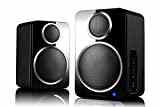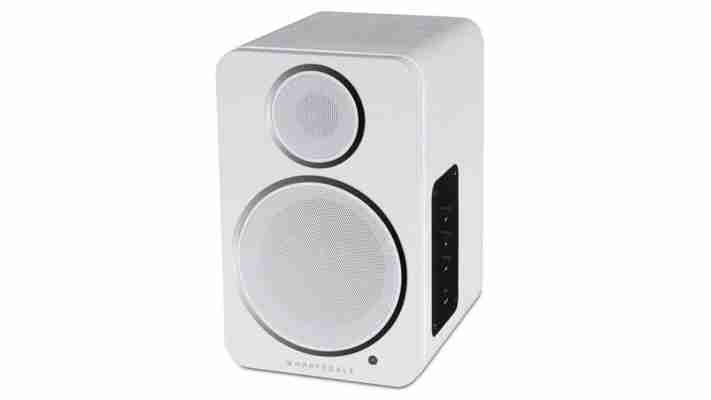Wharfedale’s DS-1 speakers were a big success when they were first launched back in 2015. Miraculously, they were able to combine a highly compact design and excellent sound quality with an attractive price tag. For just £150 they punched well above their weight.
The new DS-2 speakers, which replace the now discontinued DS-1, are slightly larger, and a touch more expensive, with the price creeping up to £179. That’s still a good price, though, and the DS-2 is a great choice for anyone that wants a compact, high-quality set of stereo speakers that will sit neatly on a desktop alongside a computer or on a shelf for more general day-to-day listening with a variety of devices.
Wharfedale DS-2: What you need to know
Wharfedale is, of course, one of the grand old names of traditional hi-fi – it can even lay claim to having invented the modern two-way speaker design that uses a separate ‘woofer’ and ‘tweeter’ for the mid- and high-range frequencies.
The company has never made much effort to compromise its traditional values in order to compete with the many low-cost computer speakers that are now available and the DS-2 is the only Bluetooth system in its somewhat old-fashioned portfolio.
The DS-2 duo are the same height as their predecessors at 190mm tall but have redesigned drivers, which means they’ve grown a little around the waist, now measuring 120mm wide. Even so, they’ll still sit comfortably on either side of a computer monitor without taking up too much space, or you can use the 1.5m (5ft) RCA cable provided by Wharfedale to place them wider apart on a convenient shelf to get better stereo separation.
Wharfedale DS-2: Price and competition
It’s a shame that the DS-2 can’t quite match the sub-£150 price tag of the DS-1, but £179 is still a decent price for such a well-made pair of speakers.
In terms of compact design, AudioEngine’s HD3 outdoes the DS-2, cramming more connectivity into a speaker that stands a mere 178mm high and 110mm wide – albeit at a price that nudges towards £400.
Another alternative would be the Q Acoustics 3010 at £159. However, the 3010 speakers require a dedicated amplifier as they're passive, unpowered speakers, and they're larger than the DS-2, at 235mm high and 200mm wide, so they’re primarily bookshelf speakers. And of course, their passive design means you don't get luxuries such as Bluetooth.



Wharfedale DS-2: Features and design
They may be a little larger than their predecessors but the smoother, rounded edges of the DS-2 speakers still look pretty trim and tidy. The speaker cabinets are very sturdily built, despite the low cost, and the black speakers we tested were finished off with a soft leather-like material. It is possible to buy the DS-2 in glossy white as well.
The right-hand speaker connects to mains power and uses the aforementioned RCA cable to connect to the passive left-hand speaker. Wharfedale provides a 3.5mm audio cable (1m long) for wired connections but it’s a little odd that the solitary 3.5mm input connector is located on the right-hand side of the right-hand speaker, rather than simply tucked away at the back (as it was with the DS-1). This meant I was left with the slightly untidy sight of the cable looping around the back of the speaker to connect to my iMac.
The other option is to use Bluetooth for a wireless connection, with AptX for devices that support it. I’m a little disappointed Wharfedale couldn’t also stretch to a USB port on the DS-2 for USB-Audio but that’s asking a lot from a set of speakers in this price range.
Wharfedale DS-2: Sound quality
The need for USB-Audio is highlighted when I connect my iMac to the DS-2, as the iMac’s analogue output through its 3.5mm connector is, frankly, rubbish. Fortunately, I have an iFi nano DAC to hand, which cleans up the audio and allows the DS-2 speakers to strut their stuff.
The lush harmonies of Queen’s Somebody To Love ring out with warmth and clarity, catching all the little details as the multi-layered vocals bounce back and forth in the climactic rondo, while Roger Taylor’s cut-glass falsetto soars above it all.
Switch to something more delicate, and the simple, wistful string arrangement of On The Nature Of Daylight by Max Richter floats through the air like autumn leaves. The plaintive sound of the violin melody tugs at the heart-strings and there’s a nice contrast with the deeper, richer tones of the cello. The DS-2 speakers aren’t spectacularly powerful. The output power is a relatively modest 30W but that proves more than enough to fill a room with Richter’s trademark ethereal sound.
The bass produced by the DS-2 is pretty respectable considering the size of the cabinets and lighter pop and rock tracks, such as Blondie’s Rapture bounce along with a relaxed, rhythmic feel. However, those compact cabinets struggle when it comes to denser, more aggressive rock.

The deep, fat guitar and bass grind of Muse’s Supermassive Black Hole is clear enough at medium volume, but the sound begins to distort as you ramp up the volume. You can almost hear the cabinets straining at the seams to contain the sheer noise of the track.
Inevitably, the sound provided via Bluetooth connections isn’t quite as clear and precise as you’ll get from a wired connection but my “CD-quality” Tidal tracks still sound pretty good. It makes a nice change, in fact, to listen to Tidal through a proper set of stereo speakers that allow the music to open up and breathe.
Wharfedale DS-2: Verdict
You wouldn’t expect a compact set of speakers like the Wharfedale DS-2 to raise the roof at party-time so the limited power of the DS-2 isn’t something that I hold against them.
But if you all you need is a compact and affordable set of speakers that can still fill a decent sizes room with clear, detailed sound then the DS-2 is hard to beat.
